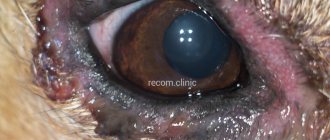Treating cat eyes
- Fact 1:
Blepharitis does have similarities and connections with conjunctivitis - Fact 2:
The edges of the eyelids thicken because the vessels experience hyperemia - Fact 3:
Let’s not “pull the cat by the tail” and say: yes, blepharitis is curable - Fact 4:
If blepharitis has developed due to the fault of microorganisms, the animal cannot avoid a course of antibiotics
Cat's eyes naturally have a magical beauty, making the pet incredibly photogenic and immediately showing signs of any disease. Unfortunately, a cat's eyes often suffer from inflammation and injury - after all, a curious mustache can't go a day without playing pranks. One of the unpleasant ophthalmological conditions plaguing the cat family is blepharitis. What does this creepy name hide, and how dangerous is such a disease for a cat?
What is blepharitis?
Unfortunately, eye diseases in cats are not very uncommon. Blepharitis is one of the most common and dangerous diseases. Knowing what the symptoms of the disease are and the first signs of an onset of illness, the owner will be able to provide first aid in a timely manner, show his pet to a specialist, and begin timely treatment.
Blepharitis is a condition in which the edges of the eyelids become inflamed, hardened, and thickened. There are several varieties of this pathology, differing in symptoms and course of the inflammatory process. An inexperienced pet owner can easily confuse the symptoms of blepharitis in cats with signs of conjunctivitis - in both cases, the animal's eyelids swell and there are various discharges from the eyes. It is very dangerous when owners are simply too lazy to seek advice from a clinic, thereby dooming their pet to prolonged suffering.
If in some forms of conjunctivitis the owner still has a chance to cure the animal with washings, then in the case of blepharitis this chance is absent - every day the pet’s suffering will only intensify.
Types of blepharitis and their symptoms
The symptoms of blepharitis are very similar to ordinary conjunctivitis. This is due to the fact that the primary symptoms are similar to each other - swelling of the eyelids and various types of discharge from the eyes. In addition, these pathologies can flow into each other, which further aggravates the confusion. Therefore, veterinarians recommend that at the first signs of eye inflammation, take the cat to a veterinary clinic, where he will be given an accurate diagnosis and prescribed the correct treatment.
Owners should understand that blepharitis comes in many varieties, each with its own specific etiology. However, there is something in common between them, in particular, severe and incessant itching in the cat’s eye area, as well as swelling and redness of the eyelids. The animal desperately rubs the area that is bothering it with its paws, which leads to painful scratching. Over time, the area of the inflammatory process expands, which leads to a decrease in the shape of the pet’s eyes and a decrease in the viewing angle. Having dealt with the general symptoms, let’s move on to the signs specific to each species, which allow us to differentiate them from each other.
Squamous blepharitis
According to experts, this type of disease is most common among representatives of the cat family. At the same time, the animal’s eyelids turn red and their edges thicken. In places where eyelashes grow, you can notice gray scales, under which pus appears. Over time, the eyelashes completely fall out, causing the cat's eyes to constantly water. She can hardly look at the light and constantly squints.
Ulcerative blepharitis
This form of the disease occurs if scaly blepharitis was not detected in time. The cat peels off the dried purulent crust, and small ulcers are found underneath it. They contribute to the penetration of other infections into the pet’s body, which worsens already painful symptoms. The ulcerated surface scars over time, thereby provoking tightening of the eyelids, and subsequently their complete inversion. Eyelids that have lost eyelashes lose their protective functions.
Allergic blepharitis
It is considered a sign of an allergen that has entered the cat’s body. The disease occurs in an acute form, associated with severe itching and pain. Photophobia manifests itself, the eyelids swell and turn red. The danger of the disease is that the owner may not know that its manifestation is associated with an allergic reaction to something. This means that constant relapses are possible.
Meibomian blepharitis
Due to infection, the meibomian glands begin to intensively secrete secretions. These glands are involved in the formation of a protective tear film for the cornea of the eye. They are clearly visible when the cat is sick with barley. The edges of the eyelid thicken and are characterized by redness. This type of disease is characterized by an abundance of secreted pus. Because of this, the eyelashes stick together and then fall out completely.
Demodectic form
It is caused by subcutaneous mites of the genus Demodex. These parasites live on the pet’s skin, eating its epithelium. They are activated if the cat’s immunity is weakened. It is difficult to treat this type of blepharitis; before starting therapy, you should definitely consult a veterinarian.
Symptoms of blepharitis
Conjunctivitis and blepharitis in cats (we posted photos of sick pets in the article) can occur simultaneously or be a consequence and complication of each other. However, there are symptoms that are unique to blepharitis. This pathology has several varieties (we will talk about this below), but there are a number of signs that are characteristic of all types of blepharitis.
The animal experiences severe itching in the eyes, and there is profuse lacrimation. At the same time, the eyelids turn red and swell. In an effort to relieve the itching, the cat tries to scratch the eye with its paw, and in this case injury cannot be avoided. Severe inflammation reduces the size of the eyes, the animal’s viewing angle is significantly narrowed, and conjunctivitis may develop against the background of blepharitis.
Symptoms
An attentive owner will immediately notice external signs of eye disease. The animal becomes restless or depressed, drowsy and refuses to eat. The cat rubs its muzzle against various objects and rubs its eyes with its paw, as it experiences pain and severe itching. Both eyelids become inflamed and swollen, profuse lacrimation appears, and then purulent discharge. In the first days, body temperature may increase.
Against the background of blepharitis, conjunctivitis (inflammation of the mucous membrane of the eye) can develop, sometimes this is the reverse process - blepharitis is added to conjunctivitis.
The diseases have similar symptoms and should only be treated by a specialist. The chronic form of the disease leads to deformation of the eyelids, dry conjunctiva and deterioration or loss of vision. There are several types of the disease with characteristic symptoms.
Squamous blepharitis
Simple (squamous) blepharitis develops slowly. After 2 or 3 months, rashes on the eyelids are added to the general symptoms, the vessels are dilated and hyperemic, the edges of the eyelids thicken, crusts form on the eyelashes - scales that fall off along with the eyelashes.
If adequate treatment is not started on time, the disease progresses and enters the next stage.
Ulcerative blepharitis
Purulent crusts form on the cat’s eyelids, the mucous membrane underneath which ulcerates. The surface of the ulcer is susceptible to any type of pathogenic flora, and the disease becomes more complicated. Not only the organ of vision suffers, but also the entire body of the animal. As the ulcers scar, the thin skin becomes deformed and an inversion or inversion of the eyelids may form. Due to damage to the hair follicles, eyelash growth stops, the eyelids do not close completely, and increased sensitivity to light appears.
Meibomian blepharitis
With an infectious lesion of the sebaceous (meibomian) glands located along the contour of the eyelid, the production of secretion increases, which becomes purulent in nature. Eyelashes stick together due to constant mucopurulent discharge.
If a kitten has a stye on the eye, there is a high risk of developing blepharitis, since the disease is most often diagnosed in young animals.
Causes of the disease
The causes of blepharitis in cats are different:
- pathogenic microflora - viruses, streptococci and staphylococci penetrate the body;
- parasitic lesions, which also affect the eyelids (most often the culprit of the disease is a subcutaneous mite);
- fungal agent, causative agent of lichen;
- allergic reactions (sometimes it is difficult to determine which food is an allergen for your pet);
- injury causing infection;
- seborrhea, characterized by dysfunction of the sebaceous glands and the appearance of dandruff, including the eyelids;
- autoimmune diseases that cause complications in the eyes;
- endocrine disorders.
In addition, the cause of the disease can be congenital cystic formations in cats. In some breeds (Burmese, Himalayan cats, Persians), the disease often develops against the background of such a hereditary disease as complete closure of the eyelids. This may cause the development of meibomian blepharitis.
Causes of blepharitis
There are many factors that lead to inflammation of the eyelid margin in pets.
- Among the most common causes are burns, including chemical ones.
- If your pet has recently taken any medications to treat another condition, the medications may have caused this reaction in the eyes.
- Incorrectly selected food can also lead to similar diseases.
- But the most common cause is various mechanical damage to the cornea or eyelids.
- If your cat often goes outside, then you shouldn’t rule out a fungal infection.
- Very often, inflammation appears against the background of renal failure.
In any case, blepharitis does not occur just like that, but is a consequence of serious problems with the pet’s health.
Incorrectly selected food can cause the development of eye diseases in cats.
Going to the veterinarian is not only about prescribing treatment. The doctor must find out the cause in order to prevent relapse in the future. The veterinarian checks whether the inflammation is due to:
- parasitic infestations;
- disturbances in the functioning of the endocrine system;
- autoimmune diseases;
- dysfunction of the sebaceous glands.
Depending on the cause of blepharitis, the symptoms of this disease also differ. Very often, correctly identified symptoms allow you to quickly find out the cause, eliminate the irritating factor and subsequently protect the animal from trouble.
Types of blepharitis: simple (scaly)
Inexperienced owners may not pay attention to this form of the disease for a long time, believing that the animal scratched its eye during a fight with fellow tribesmen or stumbled upon some sharp object. Be more attentive to your pets - if a cat has a swollen eye, this does not mean at all that she received a banal injury that will heal by itself, without your participation.
The edges of the eyelids thicken because the vessels become hyperemic. At the roots of the eyelashes, grayish scales (crusts) are clearly visible, which eventually fall off along with the eyelashes. Often, along with scaly blepharitis, a cat is also diagnosed with conjunctivitis. In the absence of proper treatment, the animal's eyelids will become covered with ulcers, and the disease will progress to the next stage.
Keratitis symptoms and treatment
If a cat's eye is inflamed and festering, examine its organs of vision in detail; in the case of keratitis, the following symptoms will appear:
- fear of light, especially sunlight;
- pus accumulates in the inner corners of the eyes, tearing intensifies;
- the diseased area seems to swell as fluid accumulates there;
- redness may be noticeable in the cornea;
- the cornea becomes cloudy;
- With advanced disease, scars may form.
Keratitis is dangerous for a cat’s vision; if left untreated, the pet may lose its vision, either partially or completely. In the case when a cat’s eye is inflamed, and the owner is completely sure that keratitis is to blame, treatment must be started urgently.
The first step is to eliminate the cause of the disease, which a rare animal owner without special education will be able to find out without the help of a veterinarian. For example, a cat has allergies, is infected, or the cause of keratitis is a fungus. Without eliminating the cause of the disease, keratitis cannot be cured, so you need to visit a veterinary clinic as soon as possible. Until the day is chosen, measures must be taken to alleviate the animal’s condition without harming it. For this it is recommended:
- Wash the cat’s eyes several times a day with a cotton pad soaked in chamomile infusion or strong tea (without flavoring additives);
- instill eye drops with antibiotic-based ophthalmic drops.
Ulcerative blepharitis
Over time, the crusts of scaly blepharitis in cats become yellow from the suppuration underneath. An ulcer is a wet wound into which infections can easily penetrate. Such a pathogenic agent significantly complicates the course of the disease, destroying the cat’s body as a whole through diseased eyes. Sometimes the ulcerative surfaces can heal, but as a result, the thin and delicate skin of the eyelids tightens in such a way that an inversion is formed.
Eyelashes do not grow because the hair follicles are damaged. The cat cannot close its eye completely, suffering from profuse lacrimation and terrible itching.
Treatment
The prescribed treatment must be adequate to the form of blepharitis, the presence of symptoms, the duration of the disease, and the general condition of the animal.
If pathogenic flora of bacterial origin is detected, antibacterial drugs are prescribed to sick animals. If the nature of the infection is viral, then treatment consists of prescribing antiviral drugs.
INTERESTING TO KNOW: Causes and treatment of entropion in cats
In addition to therapy aimed at destroying pathogenic flora, the sick cat is prescribed medications that strengthen the immune system and vitamin complexes. Local treatment consists of using medicinal ointments, drops, and rinsing agents. The entire range of drug therapy must be prescribed by a veterinarian. Self-medication can lead to serious complications in the animal, including loss of vision.
Treatment of blepharitis in cats
We told you about the signs of this disease, about its nature, you saw some rather unpleasant photos of sick animals. Perhaps someone has decided that this disease is incurable, while others are at a loss - how to treat blepharitis in cats? And is it possible to cure an animal at home?
I would like to reassure you: blepharitis in cats is curable. But successful treatment will require the active participation of the owner; the animal must feel your love and care. A sick pet will need a serious examination and competent, comprehensive treatment.
Blepharitis, which has developed due to the activity of microorganisms, requires a course of treatment with antibiotics and immunostimulants. The subcutaneous mite is so tenacious that it will take several months to get rid of it.
Veterinarians try to treat fungal infections with three vaccinations and fungicidal preparations (ointments, creams). In addition, the animal is prescribed medications for instillation and eye rinsing (ointments, drops, gels, emulsions and antibacterial suspensions).
The edges of the eyelids are disinfected using ether alcohol and a solution of brilliant green. One percent oletriic, syntomycin, gentomycin, 10% methyluracil suspensions are injected into the conjunctival sac. Scales and crusts are softened with saline solution and Vaseline ointment, after which they are removed with sterile cotton-gauze swabs.
The animal's eyes are instilled with hydrocortisone drops using Sofradex. Antibiotic treatment involves the use of not only injections, but also ointments. The use of Iris eye drops is recommended. The dosage is prescribed by the veterinarian, but usually 1-3 drops are added depending on the weight of the animal; “Conjunctivitis” (2 drops, 3 times a day for 10 days). To prevent your cat from scratching its eyes, it is advisable to put on a protective collar.
It is important to know that not all medical procedures can be performed by the owner independently. For example, you are unlikely to be able to administer antibacterial agents to the conjunctival area without the help of a specialist. It is important to carry out comprehensive treatment in order not only to get rid of blepharitis in cats, but also to prevent complications.
Diagnosis of blepharitis
The owner of the animal can easily notice the symptoms of blepharitis on his own, at home. But for an accurate diagnosis you need to see a veterinarian.
If you suspect blepharitis, you should immediately consult a veterinarian
Proper inspection requires special equipment. The veterinarian's office should have a slit lamp. The doctor examines the animal and, if possible, collects a complete medical history. In the initial stages of blepharitis, it is necessary to exclude other diseases whose symptoms are similar. The examination begins with an assessment of the general condition of the animal and the degree of damage to the eyelids. If the damage is significant, symptomatic treatment is prescribed, which must be started immediately to preserve the cat’s vision. If the doctor suspects a fungal or infectious nature of the lesion, scrapings are taken from the inflamed area of the eyelids. A complete blood test is required to assess the cat's condition.
If it is impossible to identify the cause by examination, the eyelid tissue is taken for a biopsy. After the test results have been received, the doctor makes a diagnosis and develops a treatment regimen. It is necessary to see a veterinarian once a week to assess the animal’s condition and make possible changes to the regimen.
If a disease is suspected, a general blood test is required to assess the cat's condition.
Disease prevention
In the case of blepharitis in cats, traditional preventive measures often do not work. The fact is that vaccines administered to cats only protect your pet from certain viruses. They cannot protect your furry friend from mites and bacteria. The only thing the owner can do in this situation is to protect the cat from stray and unhealthy animals.
Shoes and outerwear should always be in the closet so that the pet does not rub against shoes, which can become the source of many unpleasant diseases. Of course, you should regularly carry out preventive examinations at a veterinary clinic, which will protect your pet from many diseases, the onset of which the owner may not notice.
Prevention of blepharitis
Proper nutrition and an active lifestyle strengthen the animal’s body. To boost immunity, it is useful to give vitamin and mineral supplements.
Try to protect your pet from contact with stray and sick animals. Wash your hands when coming from outside. Put outer clothing and shoes in the closet (they can bring infection into the house).
Drafts and prolonged hypothermia have an adverse effect (especially on kittens). A healthy cat does not need to clean or rinse its eyes, but it is important to monitor their condition regularly. If a cat's eyelid becomes inflamed, this is a reason to immediately contact a veterinarian.
All information posted on the site is provided in accordance with the User Agreement and is not a direct instruction to action. We strongly recommend that before using any product, you must obtain a face-to-face consultation at an accredited veterinary clinic.
Causes
What are the causes of blepharitis in cats? What causes eye pain?
- Pathogenic microorganisms. Viruses and bacteria. Of the bacteria, the most common cause of blepharitis in cats is pyogenic cocci (staphyllo and strepto).
- Parasites, in particular subcutaneous mites (diseases called demodicosis, sarcoptic mange). Only the eyelids are affected, but also the face and neck.
- Fungi. Most often these are pathogens of trichosporia and microsporia (lichen).
- Allergy. It can be for food, medicine, dust, plants, or anything. There are thousands of allergens in nature!
- Trauma to the eye, usually a wound (for example, after a fight or self-scratching).
- Seborrhea. When the functioning of the sebaceous glands is disrupted, not only does the pet become covered in dandruff, but scales also appear on the eyelids.
- Salivary gland duct transplantation.
What kind of operations do veterinary surgeons perform? And if an animal’s lacrimal glands do not produce enough tears, then the pet has a dry eye. It's not just unpleasant, it's quite painful. And in order not to constantly drip drops (you can’t be with him for 24 hours throughout the entire life of the mustache), the ducts of the salivary glands are “transferred” surgically. But still, saliva is more “aggressive” compared to tears (saliva not only helps to moisten food in the oral cavity, but it contains many enzymes that begin to break down what has been chewed already in the mouth). This is where eye problems can arise.
- Endocrine and autoimmune diseases. The list is huge. The diagnosis can only be made by a qualified veterinarian after a comprehensive examination and a bunch of additional examinations.











